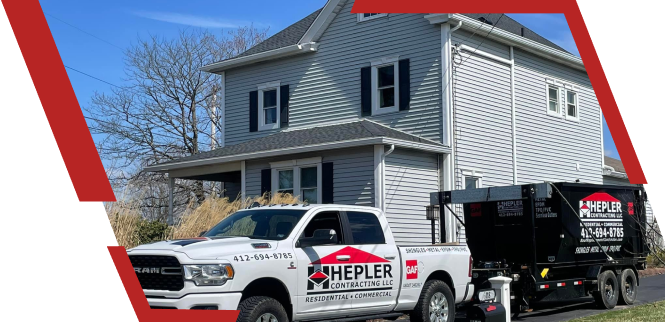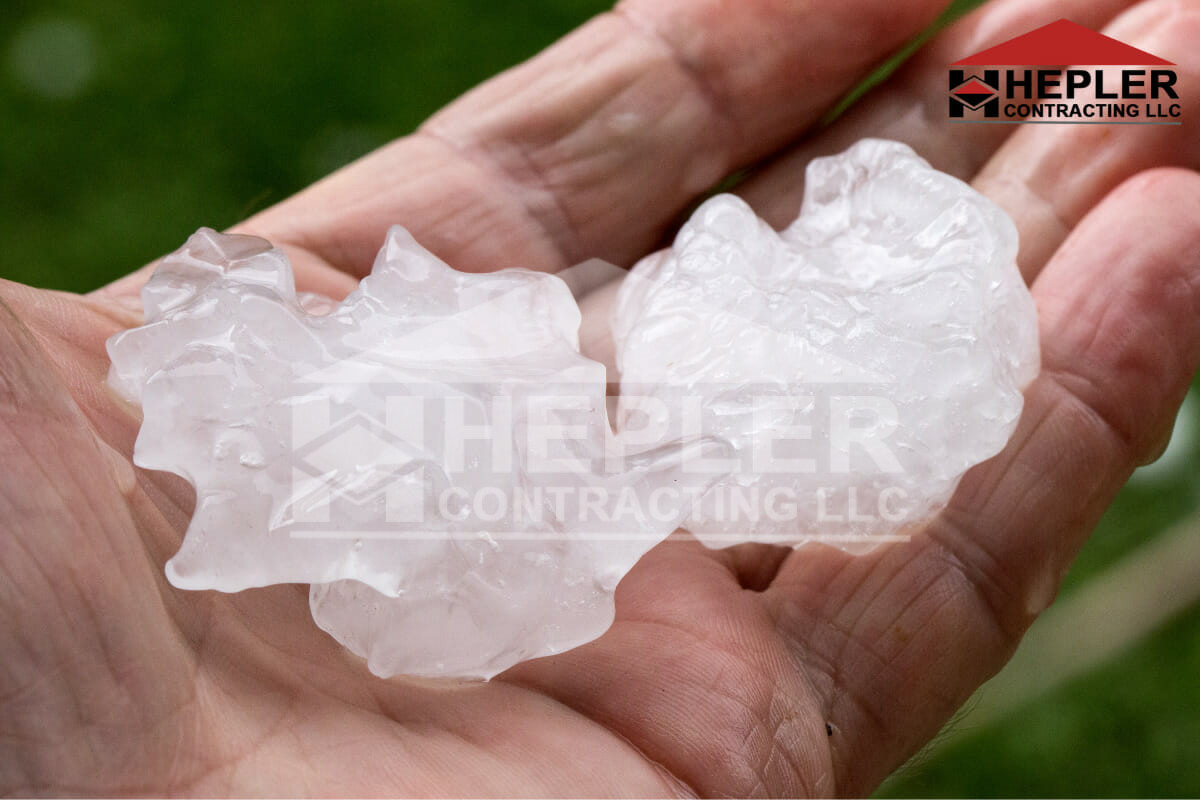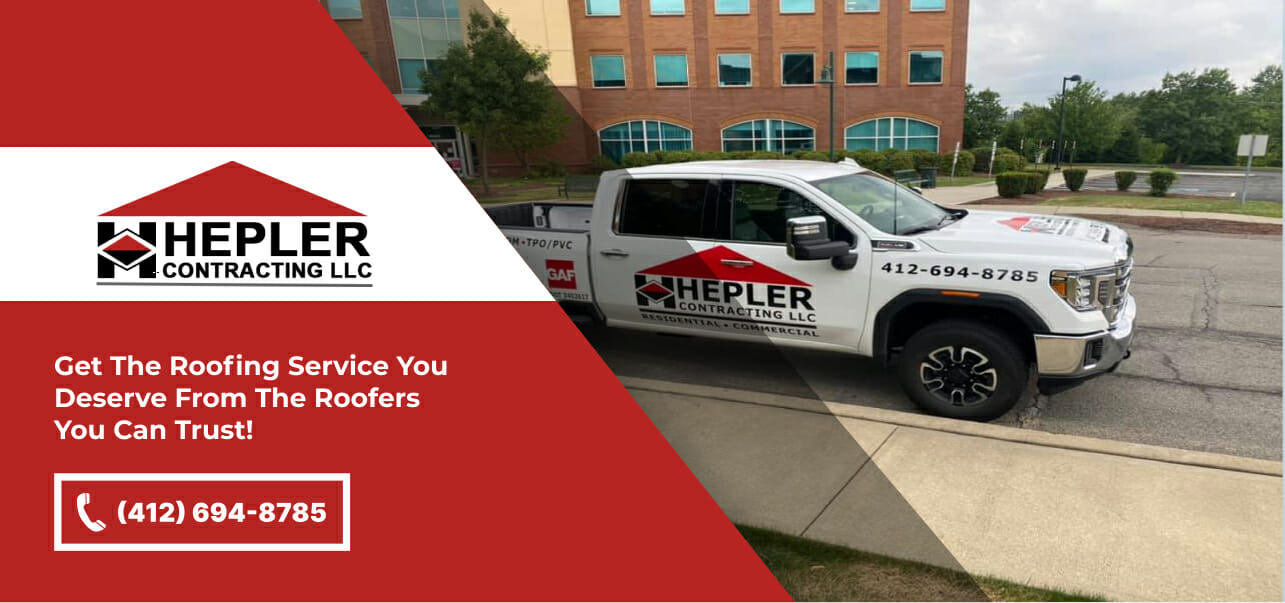A hailstorm can be a homeowner’s nightmare—and it’s not just because of the cleanup. The fact is, you may be facing the need for roof repairs or replacement, which can be costly and time-consuming.
If you’ve experienced hail damage to your roof, it’s important to assess the extent of the damage properly so you know what steps to take next.
Hepler Contracting LLC has been helping homeowners in the Greater Pittsburgh area fix hail damage to their roofs for years. In this blog, we’ll guide you through identifying the different types of roof damage from hail, assessing how bad each problem is, and deciding whether your roof needs to be repaired or replaced.
By the end of this post, you’ll have a clear understanding of your roof’s condition and how to move forward. Let’s get started!
How Does Hail Damage Affect Roofing Materials?
Have you ever wondered how hail damage affects roofing materials? As a major cause of roofing insurance claims, it’s important to understand how hailstones can damage your roof.
Formed from drops of water that freeze in the clouds, hailstones can range in size from 5 millimeters to 15 centimeters in diameter. They may be round or irregular, sometimes even jagged and pointy. When hailstones fall during a thunderstorm, they can damage a roof or other structures by hitting it at speeds between 25 and 40 miles per hour.
On average, it takes hail that is 1 inch or larger to cause damage to a regular 3-tab organic asphalt shingle. However, large hailstones that are up to 4 inches in diameter or more and fall at speeds over 100 mph can do serious structural damage to property and are a leading cause of roof insurance claims.
Hailstones can damage roofing materials in various ways, such as causing tears, fractures, punctures, and flaking of shingle granules. They can also shatter other roofing materials like wood shake, concrete, and clay tile roofing. The severity of the hail storm and the size of the hailstones play a role in determining the amount of damage that has been caused.
Now that you know more about hail damage let’s look at how it appears on your roof.
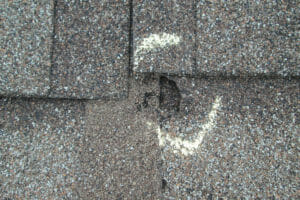
Roof damage from hail storm
What Types of Roof Hail Damage Are There?
Hail impacts to your roof can cause various damage, including bruises on the shingles, loss of shingle granules, misaligned shingles, and visible marks or dents. Insurers often categorize this damage as either functional or cosmetic in nature. Functional damage affects the performance or structure of the roof, while cosmetic damage does not and only affects the appearance.
Functional Hail Damage To Roof
There are a few signs you might have functional hail damage on your roof:
- Cracks on the shingles: When a hailstone impacts your shingles, it can cause cracks that change the look and function of the shingle.
- Fractured or broken shingles: In severe hail storms, the impact can completely break or fracture your shingles, causing pieces to fall off.
- Loss of granules: Hail damage can cause shingles to lose some or all of their protective granules, leaving areas where the granule layer is scraped off or has a hole on its surface.
Cosmetic Hail Damage To Roof
There are a few signs that you may have cosmetic hail damage on your roof:
- Dents or marks on the surface of the roof. These may be small or large and may be more noticeable on certain types of roofing materials.
- Hail spatter marks are also known as hail splatter marks. These are discolored marks or stains that are left on the roof or appliances, such as AC units, when “slushy” type hail falls.
- Damage to gutters, downspouts, or other roofing components that do not affect their functionality.
It’s important to note that cosmetic hail damage does not typically affect the performance or structure of the roof. In these cases, a roof claim may not be necessary. However, if the damage is causing problems with the appearance, you can repair or replace the particular part.
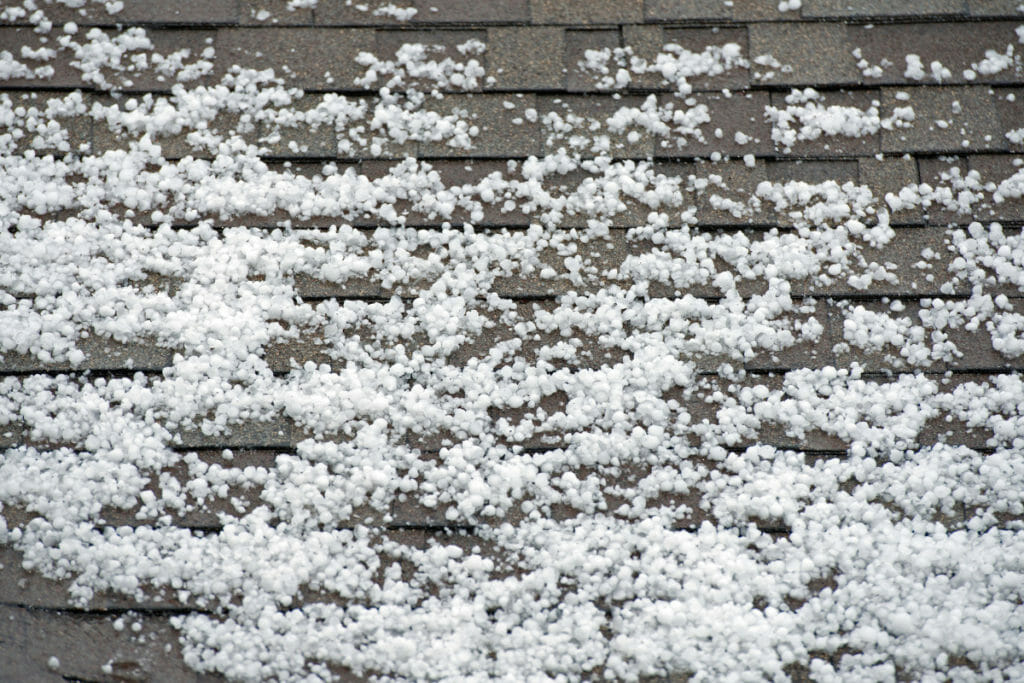
Does Hail Damage On Roof Appear Immediately After A Hail Storm?
You might be wondering if hail damage on a roof is immediately visible after a hail storm. The answer is that it can be both visible and invisible, depending on the size of the hailstones and the storm’s severity. Large hailstones can cause visible damage right away, but smaller hailstones can still cause damage that may not be noticeable until months or even years later.
That’s why conducting a hail damage roof inspection is important, even if the damage is not immediately visible. Our professional roofing company can help identify any hail damage to your roof and determine the best course of action for repair or replacement. Trust us, it’s always better to address any hail damage as soon as possible to prevent further damage from occurring and extend the life of your roof.
Does Insurance Cover Hail Damage?
When it comes to hail damage, it is important to check with your insurance provider to see if your roof is covered under your policy. Most homeowners insurance policies do include coverage for hail damage to the roof, but the specifics of this coverage can vary depending on your location, your insurance company, and the details of your policy. It is always a good idea to review your policy and consult with your insurance provider to understand the specific terms of coverage for hail damage.
According to Restoration Builders, insurance companies often require a certain amount of hail damage to have occurred to your roof before paying out money for a full roof replacement. This may include multiple “hits” or damaged spots on three different areas of the roof. It’s always a good idea to consult with a professional roofing company or your insurance provider to assess the severity of the damage and determine whether the best course of action is repair or replacement.
Assessing The Severity Of Hail Damage
A professional roof inspection is the most effective way to determine the severity of a roof’s hail damage. Inspections are necessary because hail damage may be hard to spot, especially if it’s not immediately visible from the ground.
You can follow these steps to inspect your roof for hail damage:
To begin the inspection process, start from the ground and work your way up to the peak of your roof. Look for signs of hail damage on the ground, such as broken branches or leaves with holes. This can give you an idea of the size and severity of the hail that fell during the storm. Sometimes, you may even find physical hail scattered around your lawn if the temperature is still cold.
Next, take a walk around the exterior of your home and look for any visible damage on the roof. This can include dents in the shingles, missing or damaged flashing, or broken gutters. Pay special attention to areas of the roof that may be more prone to damage, such as corners and valleys.
If you are able to safely access the roof, carefully inspect it for any additional signs of hail damage. This can include checking the underside of the roof, looking for any visible damage to the roof shingles, and inspecting the attic for any leaks or water damage.
It’s also a good idea to take photos or videos of the damage, as this can be helpful in documenting the damage for insurance purposes.
If you are unable to inspect the roof yourself safely, or if you are unsure of the extent of the damage, it’s always a good idea to seek the advice of a professional roofing company. They will be able to assess the damage on your roof with proper safety measures and provide recommendations for repair or replacement.
So, Should You Repair Or Replace Your Roof?
When your roof sustains hail damage, deciding whether to repair or replace parts of your roof can be difficult. There are a few key factors to consider when making this decision, including the cost of repair versus replacement, the age and condition of the roof before the hail damage, and the extent of the damage itself.
First and foremost, it’s important to assess the cost of repairs versus replacement. If the damage is minor and confined to a small area, a repair may be a more cost-effective option. However, replacing the entire roof may be more cost-effective if the damage is widespread and affects more than 30 percent of your roof.
Another important factor to consider is the age and condition of your roof prior to the hail damage. If your roof is already in poor condition or near the end of its lifespan, replacing it is a good idea rather than investing in repairs. This will save you the hassle of repairing your roof again and again.
On the other hand, if your roof was in good condition before the hail damage, a repair may be a more appropriate choice.
Finally, the extent of the damage itself is an essential factor to consider. A repair may be sufficient if the damage is minor and isolated to a small area. However, replacement may be necessary if the damage is extensive and affects a large portion of your roof.
Ultimately, the decision to repair or replace your roof following hail damage is a personal one that should be based on your specific circumstances. It’s always a good idea to consult with a professional roofing company to thoroughly assess the damage and determine the best course of action.
Get An Expert Opinion On Your Roof Damage From Hail
If you think hail has damaged your roof in Pittsburgh, call a professional roofing company for an inspection as soon as possible. Most homeowners’ insurance policies cover hail damage, even if the roof is old. However, it can be challenging to determine how much hail damage is required to file a claim or whether a repair or a full roof replacement is necessary.
That’s where our team comes in. Hepler Contracting LLC offers free roof inspections to assess the extent of the damage and provide full documentation. Our experienced inspectors will be able to guide you on the next steps, whether that be a repair or a replacement. They will also be able to advise you on whether or not it’s worth pursuing an insurance claim based on the amount of damage present. Feel free to reach out to us for a thorough inspection and expert guidance. Contact us today at (412) 694-8785!
Bonus Tip: Prevention Is Key
We know how important it is for you as a homeowner to protect your roof from hail damage. After all, a roof is a significant investment and can be costly to repair or replace if it is damaged by hail. So, how can you prevent hail damage to your roof?
Here are a few tips that may be helpful:
First of all, consider installing hail-resistant shingles. These shingles are specifically designed to withstand the impact of hail, making them a great option for areas that are prone to severe weather. Another option is to install a hail-resistant roof coating. This coating is applied to the roof’s surface and provides an extra layer of protection against hail damage.
Additionally, it’s a good idea to keep trees trimmed. Overhanging tree branches can damage your roof during a hail storm. This is why it’s important to keep them trimmed and away from your roof.
By following these tips, you can help protect your roof from hail damage and keep it in top shape for years to come. Remember, prevention is key when it comes to protecting your home from the elements. So take the time to ensure your roof is ready to withstand a hail storm.
